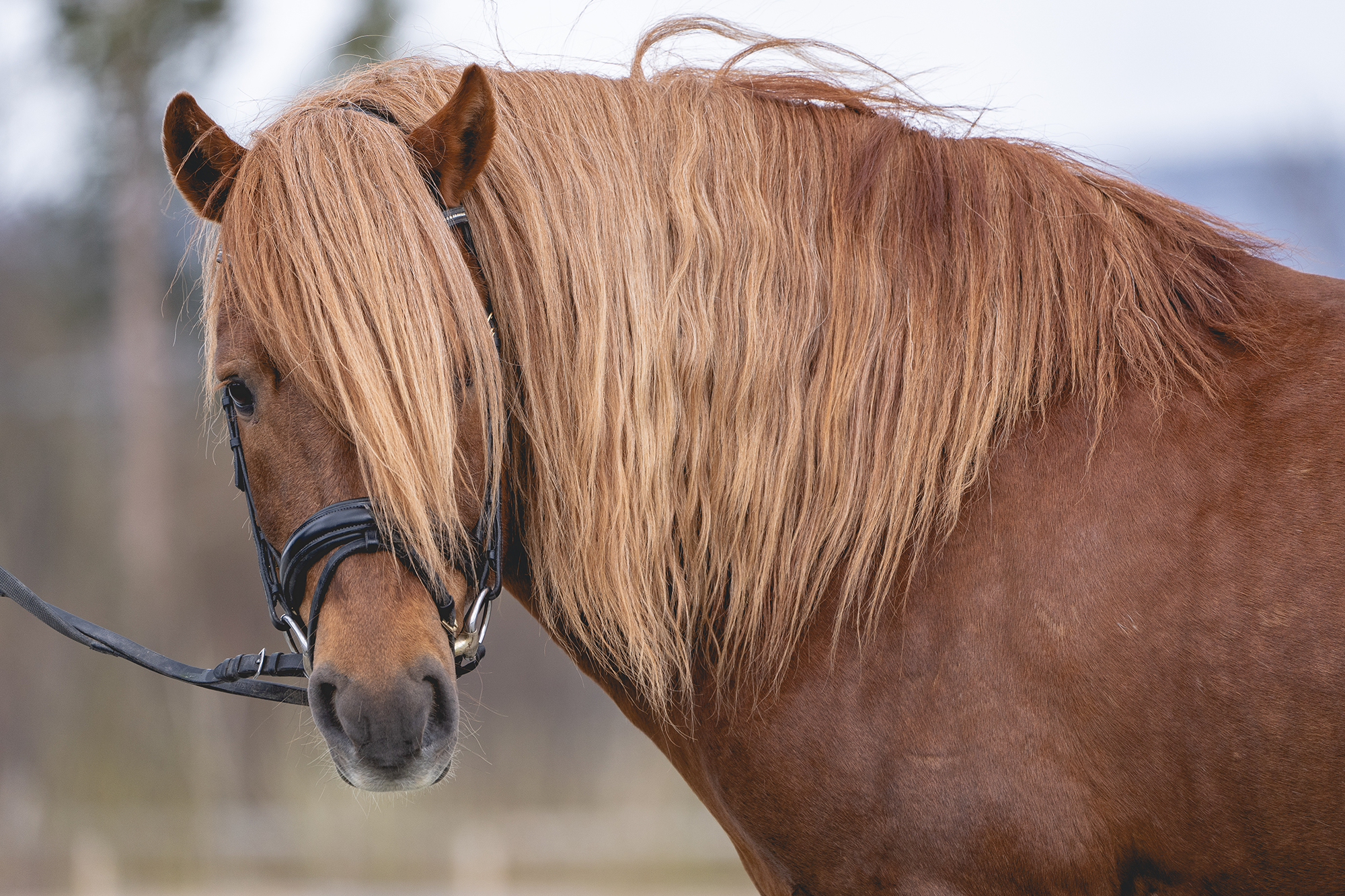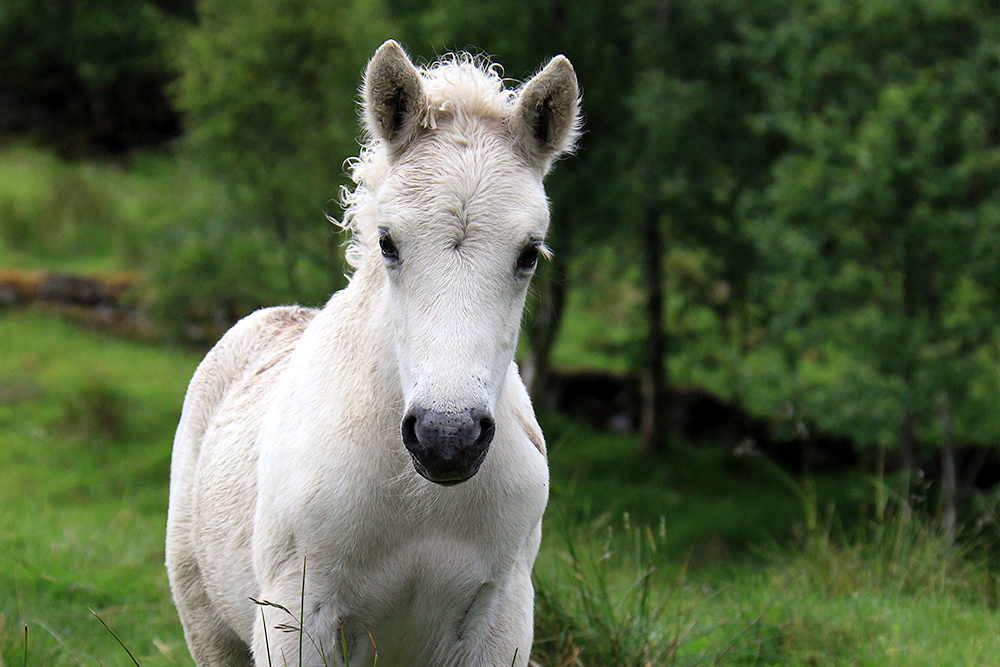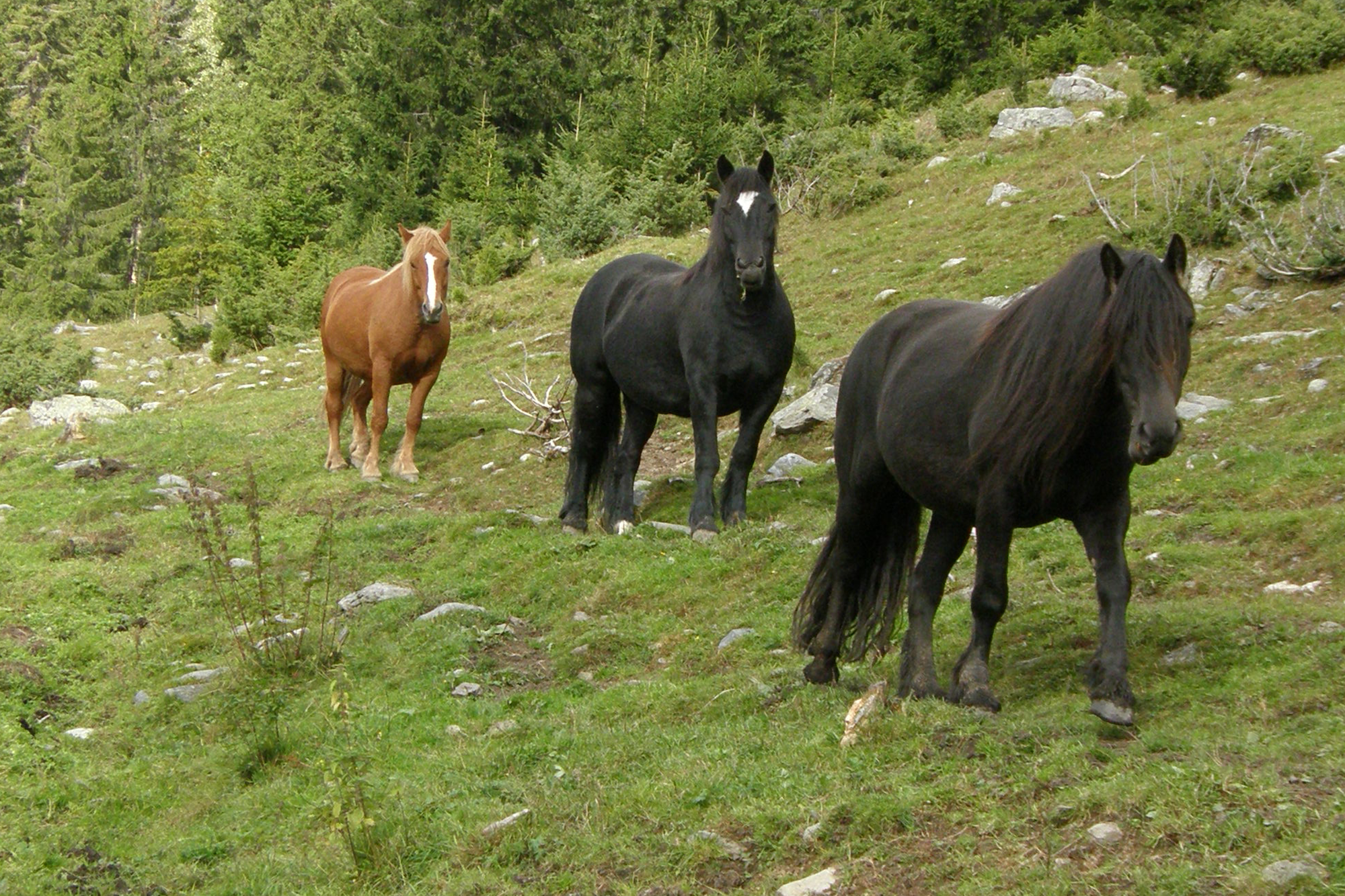


Norwegian Dole horse. Photo: NIBIO
3.5 Norway
Background
Like in other countries, horses in Norway were traditionally used for farming, but at present most horses are used for leisure and sporting activities. The Norwegian Fjord horse is probably the most well-known horse breed from Norway, and is found in many countries all over the world. The Dole horse, the Nordland/ Lyngen horse and the Norwegian Coldblooded trotter are the other native horse breeds in Norway. Except for the Coldblooded trotter, the other native breeds are considered endangered. Several of the native horse breeds have also been subjected to transboundary breeding. For example, Norwegian and Swedish trotters share breeding material/ stallions since the 1990’s. Furthermore, the Nordland/ Lyngen horse has been bred with an imported Finnhorse stallion in 1979, and traces of the Finnhorse can be found in most pedigrees of this breed today.
Organization and registration of horse breeding in Norway
The main legislative body for horses in Norway is the Norwegian Food Safety Authority (Mattilsynet). This authority is responsible for regulating breeding, registration and keeping of horses. Norway follows the EU laws with some adaptions. In 2017, it was made mandatory for information registered with passport-giving organizations to be reported to the National Horse Registry. There are currently eight organizations that have been given the authority to issue EU passports in Norway. These have all been given this authority by the Norwegian Food Safety Authority (Mattilsynet), and some of them have their own agreement with different gene banks for gene banking activities such as semen collection and storage.
The Norwegian Food Safety Authority (Mattilsynet) have given the authority to issue EU passports in Norway to the following organizations:
- Norsk Hestesenter
- Norsk Varmblod
- Norsk Ponniavlsforening
- Det Norske Travselskap
- Norsk Araberhestforening
- Norsk Galopp
- Norsk Lipizzanerforening
- Dansk Varmblod Norge
Population statistics
According to the National horse registry in Norway, a total of 85 291 live horses and 2026 foals born were registered in Norway in 2022 (Table 4).
Breed Name | N total | N foals born |
Coldblooded trotter | 17,053 | 435 |
Warmblooded trotter | 14,515 | 380 |
Icelandic horse | 11,560 | 230 |
Warmblooded Riding horse | 7,293 | 218 |
Norwegian Fjord horse | 6,172 | 182 |
Shetland Pony | 4,972 | 96 |
Norwegian Dole horse | 4,270 | 164 |
Norwegian Nordland/ Lyngen horse | 3,159 | 115 |
English Thoroughbred | 1,982 | 41 |
Other breeds | 5,750 | 75 |
Crossbreed/Unknown breed | 8,565 | 90 |
Total | 85,291 | 2,026 |
Table 4: Number of living horses and number of foals born in Norway in 2022. Data from the National Horse Registry. Some imported horses may not be registered in the National Horse Registry, and the real number of horses might be higher.
Breed statistics for the native breeds – data discrepancies between DAD-IS and national reports
Data collected from both DAD-IS and national reports are presented below for all the native breeds. They show similar discrepancies in the reporting in DAD-IS compared to reports from the Norwegian Horse Association (NHS) and the Norwegian genetic resource centre (NIBIO) with regards to population development and available breeding mares. For instance, DAD-IS indicates that the Fjord horse population has been declining at a steady pace since 1988, except for a large jump and then drop in the early and late 1990s (Figure 6A). This jump in number could be a technical error. The reported numbers corresponds to the population of breeding mares which also appear to have been steadily declining until 2021, which is a similarity for all of the breeds (Figure 6 and 7) Since 2021 the population and number of breeding mares in each of this breeds appear to have increased, according to DAD-IS. However, when comparing these numbers to national reports from both NIBIO and the NHS, the numbers differs for both number of breeding mares and population size (Figure 6, 7 and 8). Key figures presented from Norway show that the number of mares available for breeding presented in 2019-2022 is higher than those presented in DAD-IS (Figure 6 and 7). The number of mares presented in DAD-IS up to 2022 appear to correspond better to the number of mares used for breeding presented in NHS. The number of breeding mares presented in DAD-IS in the year 2022 corresponds to the number of mares available for breeding, and not the number of mares actually used for breeding (i.e., mares used for breeding was determined by counting number of foals born – e.g. not counting those who did not carry to term), suggesting an alteration for defining “breeding females” in DAD-IS in 2022.
Figure 6A.1: The population number of the Fjord horse. The figure illustrated the population of the Fjord horse reported into DAD-IS between the late 1900’s and 2022.
Figure 6B.1: The population number of the Dole horse. The figure illustrated the population of the Dole horse reported into DAD-IS between the late 1900’s and 2022.
Figure 6A.2: The number of mares available for breeding in the Fjord horse population. The figure illustrates the number of Fjord horse mares available for breeding reported by NIBIO (yellow) compared to DAD-IS (blue).
Figure 6B.2: The number of mares available for breeding in the Dole horse population. The figure illustrates the number of Dole horse mares available for breeding reported by NIBIO (yellow) compared to DAD-IS (blue).
Figure 6A.3: The number of Fjord horse mares used in breeding. The figure illustrates the number of breeding Fjord horse mares reported by NHS (light blue) and DAD-IS (blue) between 2013 and 2022.
Figure 6B.3: The number of Dole horse mares used in breeding. The figure illustrates the number of breeding Dole horse mares reported by NHS (light blue) and DAD-IS (blue) between 2013 and 2022.
Figure 7A.1: The population number of the Nordland/ Lyngen horse. The figure illustrated the population of the Nordland/Lyngen horse reported into DAD-IS between the late 1900’s and 2022.
Figure 7B.1: The population number of the Norwegian Coldblooded trotter. The figure illustrated the population of the Norwegian Coldblooded trotter reported into DAD-IS between the late 1900’s and 2022.
Figure 7A.2: The number of mares available for breeding in the Nordland/ Lyngen horse population. The figure illustrates the number of Nordland/ Lyngen horse mares available for breeding reported by NIBIO (yellow) compared to DAD-IS (blue).
Figure 7B.2: The number of mares available for breeding in the Norwegian Coldblooded trotter population. The figure illustrates the number of Norwegian Coldblooded trotter mares available for breeding reported by NIBIO (yellow) compared to DAD-IS (blue).
Figure 7A.3: The number of Nordland/ Lyngen horse mares used in breeding. The figure illustrates the number of breeding Nordland/ Lyngen horse mares reported by NHS (light blue) and DAD-IS (blue) between 2013 and 2022.
Figure 7 B.3: The number of Norwegian Coldblooded trotter mares used in breeding. The figure illustrates the number of breeding Norwegian Coldblooded trotter mares reported by NHS (light blue) and DAD-IS (blue) between 2013 and 2022.
When comparing the population number that has been reported in DAD-IS with the number of total reported population and total available breeding population that has been reported by the NHS, these numbers are completely different in all the breeds (Figure 6). These findings suggests that different definitions have been used for reporting population number and number of breeding mares have been used. It is important to highlight the significance of consistent reporting because it influences the historical perspective of development for the breeds. For example, following solely data entries into DAD-IS, the breeding mares for all of the native breeds appear to be experiencing an increase, when in reality, the mares available for breeding are slightly decreasing and the number mares used in breeding appear stable (Figure 6 and 7). The same trend is seen for the population number. In DAD-IS it appears to be increasing drastically from 2021 to 2022, while the total number of animals and the total number of animals available for breeding appears to either be stable of decreasing (Figure 8) Additionally, when viewing the population data compared to population numbers presented. These findings highlights the importance of clear definitions and consistency of reporting into DAD-IS so that interested parties (e.g., scientists or policy markers) can obtain the correct desired information from one place. Reviewing the number of mares available for breeding presented by NIBIO, the trend is showing a slight decrease from 2019 to 2022.
Figure 8A: The population number of the Fjord horse. (Norsk Hestesenter, 2023, 2022, 2021, 2020, 2019, 2017, 2016). The figure illustrates the total population of the Fjord horse from 2016 to 2022 according to DAD-IS (dark blue) and NHS (yellow and light blue). The definition of total population derived from NHS is divided in two (total population available for breeding (yellow) and all individuals within the population (light blue)).
Figure 8B: The population number of the Dole horse. (Norsk Hestesenter, 2023, 2022, 2021, 2020, 2019, 2017, 2016). The figure illustrates the total population of the Dole horse from 2016 to 2022 according to DAD-IS (dark blue) and NHS (yellow and light blue). The definition of total population derived from NHS is divided in two (total population available for breeding (yellow) and all individuals within the population (light blue)).
Figure 8C: The population number of the Nordland/ Lyngen horse. (Norsk Hestesenter, 2023, 2022, 2021, 2020, 2019, 2017, 2016). The figure illustrates the total population of the Nordland/ Lyngen horse from 2016 to 2022 according to DAD-IS (dark blue) and NHS (yellow and light blue). The definition of total population derived from NHS is divided in two (total population available for breeding (yellow) and all individuals within the population (light blue)).
Figure 8D: The population number of the Norwegian Coldblooded trotter. (Norsk Hestesenter, 2023, 2022, 2021, 2020, 2019, 2017, 2016). The figure illustrates the total population of the Norwegian Coldblooded trotter from 2016 to 2022 according to DAD-IS (dark blue) and NHS (yellow and light blue). The definition of total population derived from NHS is divided in two (total population available for breeding (yellow) and all individuals within the population (light blue)).
Commercial horse and breeding activities
The Standardbreds and Coldblooded trotters are the most common breeds in Norway. Trotting is a popular sport in Norway. Breeding and training of the competing horses are part of commercial activities and can generate income for the most winning trotter horses and breeding stallions.
The Norwegian Coldblooded trotter was developed from lighter/faster types of Dole horses and has a lot in common with the Swedish Coldblooded trotter. The Norwegian and Swedish Coldblooded trotters share horses/stallions and collaborate breeding efforts across the borders. Although the population is large, inbreeding remains a concern because of the extended use of “Matador” stallions (i.e., few stallions that produce most of the offspring).
Economy
The equine industry in Norway includes popular trotting races, dressage, jump and other horse sports, riding schools and private leisure and some tourism riding. Most of the economy in the horse sector is driven by servicing the horse owners such as providing horse feed, hoof care, and veterinarian care, but there are also some commercial activities (e.g., within trotting and sporting communities or for riding schools.
Native breeds and conservation programs
There are four native breeds in Norway: Norwegian Fjord horse (Fjordhest), Norwegian Dole horse (Dølahest), Norwegian Nordland/Lyngen horse (Nordlandshest/ Lyngshest) and Norwegian Coldblooded trotter (Norsk Kaldblodstraver). The Fjord, Nordland/Lyngen and Dole horse breeds are considered endangered, while the Coldblooded trotter is considered as vulnerable. The three endangered native breeds are managed by NHS, and their individual breed associations. The Norwegian Coldblooded trotter is managed by the Norwegian Trotting Association (Det Norske Travselskap).
The Fjord, Nordland/Lyngen and Dole horse breeds are small-sized working horses and were traditionally used for farming. They are small compared to other international working horses, which make them ideal for the Norwegian mountain and fjord terrain. The Fjord horse was developed in the west, the Dole horse in the east and the Nordland/ Lyngen horse in the north of Norway. Today the native horses are mostly used for leisure. They are popular with children and for therapy due to their gentle nature. The horses can also be used for sports. There are National Championships for Fjord, Dole, and Nordland/ Lyngen horses, where they compete in different horse sports like jumping, dressage and driving.
Each breed has their own conservation plan. There are also regional horse centres; the Norwegian Fjord Horse Centre (Norsk Fjordhestsenter) on the west coast of Norway, the National Center for Nordland/ Lyngen Horse (Nasjonalt senter for Nordlandshest/Lyngshest) in Northern Norway, and NHS that is also the National Center for Dole Horse in Eastern Norway. NHS publish annual statistics regarding the population development and inbreeding of the breeds. The association also acts as an advisory concerning both inbreeding management and conservation. The responsibility of breeding and registering horses lies within the breed associations themselves.
Gene banking activities
There are no organised national gene bank activities for the native Norwegian horses, but the passport-giving organisations have individually organized agreements with gene banks.
Subsidies
Because native breeds are endangered, there is a need to support breeding of foals and conservation activities for the horses. The three native breeds that are endangered: Nordland/ Lyngen horse, Dole horse and Fjord horse can receive subsidies for young horses less than 3 years of age. Nevertheless, statistics show that only 60% of the young horses that were eligible for subsidies in 2023 received them. The reason for why the remaining horses did not receive them is unknown The Norwegian Horse Center (NHS) is responsible for the conservation of the native breeds, and are provided with subsidies from “Landbruks- og matdepartementet” to preserve the breeds.